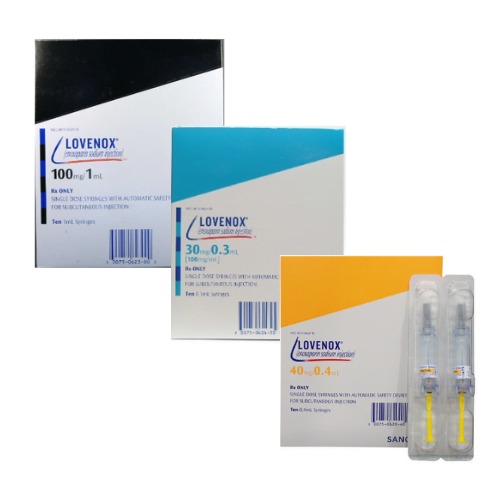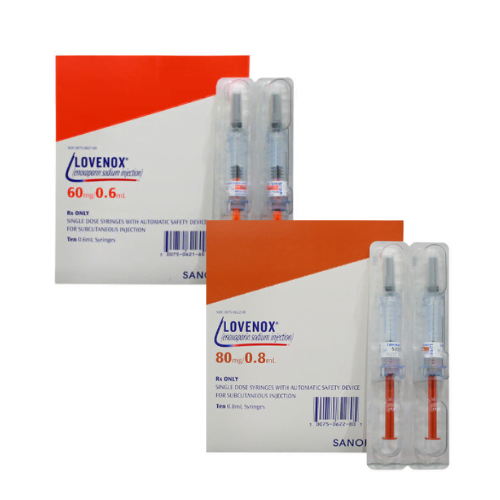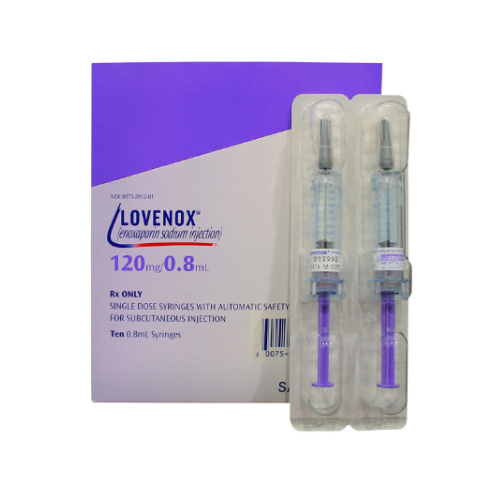Please note: a valid prescription is required for all prescription medication.
Lovenox® Injections for Blood Clot Prevention and Treatment
Sitewide Super Sale - Get 15% off when you buy 3 or more of the same product using the code LESS15 at checkout.
Applies to all products originating from Canada. Maximum quantity limited to a 90-day supply per order.
Price range: $120.99 through $472.99
You save


This anticoagulant injection helps prevent and treat blood clots in at-risk adults. You can order with US shipping from Canada, which may help if you pay without insurance. Use this page to understand how it works, who it suits, safe use, and how to access it.
What Lovenox Is and How It Works
Lovenox® contains enoxaparin, a low molecular weight heparin. It enhances antithrombin activity, which reduces factor Xa and thrombin activity. That action lowers your risk of forming or extending clots.
CanadianInsulin.com is a prescription referral platform. We verify prescriptions with your prescriber when required, and licensed Canadian pharmacies dispense your order.
This treatment is used to prevent deep vein thrombosis in surgical or medically ill patients and to treat established venous thromboembolism. It is also used with antiplatelet therapy in certain acute coronary syndromes, such as unstable angina or non–ST elevation myocardial infarction. Your prescriber chooses a regimen based on indication and renal function.
Many patients receive enoxaparin sodium injections in prefilled syringes for consistent dosing. The medicine is injected under the skin, not into muscle. Your care team will show you where and how to give doses safely.
Who It’s For
This medicine may be prescribed to lower the risk of deep vein thrombosis after hip, knee, or abdominal surgery, and in acutely ill medical patients with limited mobility. It also treats clots in the legs or lungs and supports care in some heart conditions. Learn about venous clot conditions on our Blood Clot DVT PE page.
People often use lovenox shots for blood clots when oral therapy is not preferred or is delayed. Those with active major bleeding, a history of heparin-induced thrombocytopenia, severe uncontrolled hypertension, or a known allergy to heparin, enoxaparin, or pork products should not use it.
Use caution if you have reduced kidney function, are older, have low body weight, or use neuraxial anesthesia. Your clinician will consider risks for spinal or epidural hematoma if you have a spinal puncture or an indwelling catheter.
Dosage and Usage
Clinicians select dose and schedule by indication. Prophylaxis and treatment regimens differ, and dosing may change with kidney impairment. Follow the exact directions on your prescription label.
For home use, your team may train you in lovenox self injection. Wash hands, clean the site with alcohol, and let it dry. Inject into the fatty layer of the abdomen, at least two inches from the navel. Rotate sites with each dose to reduce skin irritation.
Point the needle straight in at a 90-degree angle unless you are advised otherwise. Do not rub the site after injecting. Do not expel the small air bubble in prefilled syringes unless told to do so. Never inject into muscle.
Do not change your dose or schedule without medical guidance. If you have sudden bleeding, severe pain, or signs of a spinal problem after neuraxial procedures, seek urgent care.
Strengths and Forms
This treatment is supplied in single-use prefilled syringes. Common presentations include 40 mg/0.4 mL and 80 mg/0.8 mL; availability may vary by pharmacy.
A lovenox injection syringe is designed for one dose only. Do not reuse needles or syringes. If you need a different amount, your prescriber will specify the correct syringe size.
Missed Dose and Timing
If you miss a dose, take it when you remember unless it is close to the next dose. If it is near the next scheduled time, skip the missed dose. Do not double up doses. Keep injections at consistent times each day for steady effect.
Storage and Travel Basics
Store syringes at room temperature away from heat and moisture. Keep them in the original carton to protect from light and to have the label for travel. Do not freeze the product. Keep out of children’s reach.
When traveling, carry doses in your hand luggage with your prescription label. Bring a sharps container or a plan for safe disposal at your destination. If crossing time zones, ask your clinician or pharmacist how to adjust timing to maintain regular intervals.
Pen Handling and Sharps Disposal
These are prefilled syringes, not pens. After use, place the needle and syringe into an FDA-cleared sharps container right away. If you do not have one, use a heavy-duty plastic household container with a tight lid until you can obtain a sharps container.
Do not recap, bend, or clip needles. Follow local rules for sharps disposal. Your clinic or pharmacy can direct you to community drop-off sites.
Benefits
As a low molecular weight heparin, this medicine offers predictable anticoagulant effect for many indications. Prefilled syringes simplify dosing without mixing. Subcutaneous use allows treatment outside the hospital when appropriate.
For some patients, early parenteral therapy is valuable while assessing oral options. Explore heart and vessel topics in our Cardiovascular category to learn more about related conditions and therapies.
Side Effects and Safety
- Injection site pain or bruising — usually mild
- Bleeding of gums or nose — monitor for persistence
- Easier bruising — report unusual patterns
- Low red blood cell count — may be observed on labs
- Elevated liver enzymes — typically transient
- Low platelets — rare but serious concern
Serious bleeding can occur at any site. Rarely, immune-mediated heparin-induced thrombocytopenia may develop, which can cause clotting complications. Spinal or epidural hematomas may occur in patients on neuraxial anesthesia, with potential for long-term or permanent paralysis. Seek urgent care for severe headache, weakness, numbness, vision changes, coughing or vomiting blood, black stools, or severe back pain.
Drug Interactions and Cautions
Using other anticoagulants or antiplatelets can raise bleeding risk. Examples include warfarin, direct oral anticoagulants such as Apixaban and Dabigatran, and antiplatelets such as Clopidogrel. Nonsteroidal anti-inflammatory drugs, SSRIs, and SNRIs may also increase bleeding tendencies.
Tell your clinician about spinal procedures, spinal deformity, or a planned spinal or epidural catheter. Carefully follow timing guidance around catheter placement and removal to lower neuraxial bleeding risk. Nurses and caregivers can review safe practices in our Apixaban Nursing article, which discusses medication safety more broadly. For antiplatelet education, see Clopidogrel 75 mg.
What to Expect Over Time
With consistent use, you may notice fewer new bruises from procedures or improved comfort as clot symptoms are managed. A lovenox shot can cause a small, firm spot under the skin that usually fades. Expect periodic lab and clinical assessments to reassess clot risk and bleeding risk. Your prescriber may transition you to an oral anticoagulant when appropriate.
Compare With Alternatives
Oral direct factor Xa inhibitors offer tablet options for many of the same indications. Eliquis® is an example used for prevention and treatment of venous thromboembolism and for certain cardiac conditions. Vitamin K antagonists such as Warfarin remain a standard for selected patients, especially with mechanical heart valves or specific clinical needs. Your clinician will match therapy to your diagnosis, comorbidities, and monitoring preferences.
Pricing and Access
Canadian pricing can reduce out-of-pocket costs, and we support US access with care. If you compare options, check the lovenox injection price alongside clinical needs and dosing frequency. If you prefer an oral anticoagulant, review pricing for alternatives such as Pradaxa® on its product page. For savings updates, see our Promotions page.
We offer transparent checkout and clear product details. Many shoppers look for coupons or discounts on enoxaparin; availability can vary by product and pharmacy. Browse, add to cart, and review the final total before placing your order.
Availability and Substitutions
Supply can vary by strength and package size. If your prescribed presentation is unavailable, your prescriber may recommend a suitable alternative or adjust the plan. Oral agents such as Apixaban or other direct thrombin inhibitors like Dabigatran may be considered when appropriate.
Patient Suitability and Cost-Saving Tips
This therapy may fit patients who need short-term parenteral anticoagulation, are bridging to procedures, or have conditions where oral therapy is unsuitable. It may not suit those with active bleeding, a history of HIT, or uncontrolled severe hypertension.
To save on total expense, ask about multi-month prescriptions if clinically appropriate, which can reduce refill fees. Set refill reminders to prevent gaps in therapy. Compare unit costs across syringe sizes to make an informed choice. Our encrypted checkout protects your information throughout the order process.
Questions to Ask Your Clinician
- Indication and goal — why this anticoagulant is recommended
- Dose and schedule — how long you will need injections
- Bleeding plan — when to seek care and what to monitor
- Injection technique — where to inject and rotation plan
- Neuraxial procedures — timing around spinal anesthesia
- Drug combinations — which pain relievers are safer
- Transition — when to switch to an oral agent
Authoritative Sources
For full prescribing information, see the manufacturer’s label on Sanofi’s site, or consult national drug databases. These references provide complete indications, contraindications, and administration guidance:
- US Prescribing Information on FDA site, with indications and safety details
- DailyMed monograph for enoxaparin, including dosage and warnings
- Health Canada Drug Product Database, official Canadian product listings
Order today for prompt, express shipping with temperature-controlled handling when required.
Medical disclaimer: This content is for informational purposes only and is not a substitute for professional medical advice.
Express Shipping - from $25.00
Shipping with this method takes 3-5 days
Prices:
- Dry-Packed Products $25.00
- Cold-Packed Products $35.00
Standard Shipping - $15.00
Shipping with this method takes 5-10 days
Prices:
- Dry-Packed Products $15.00
- Not available for Cold-Packed products
How do I inject a prefilled syringe safely?
Wash hands, clean the site, let it dry, and inject into the abdomen’s fatty layer. Rotate sites, do not rub after, and dispose of the syringe in a sharps container.
Can I take pain relievers while using this medicine?
Avoid NSAIDs like ibuprofen unless your clinician approves, because they can increase bleeding. Acetaminophen is often preferred, but confirm with your clinician.
What if I see a lot of bruising at the injection site?
Small bruises are common. Use gentle pressure after injecting and rotate sites. If bruising is large, painful, or spreading, contact your clinician.
Do I need blood tests while on therapy?
Routine anti-Xa monitoring is not typical for most adults, but your clinician may order labs to check blood counts or kidney function based on your situation.
Is it safe with spinal or epidural anesthesia?
There is a risk of spinal or epidural hematoma. Timing doses around catheter placement and removal is critical. Your surgical and anesthesia teams will guide the plan.
How is this different from unfractionated heparin?
Low molecular weight heparin has a more predictable effect and is injected under the skin, often without routine lab monitoring. Unfractionated heparin usually requires IV use and closer monitoring.
Can I switch to an oral anticoagulant later?
Many patients transition to an oral agent once stable. Your clinician will decide if and when a switch is appropriate based on your diagnosis and risk profile.
Rewards Program
Earn points on birthdays, product orders, reviews, friend referrals, and more! Enjoy your medication at unparalleled discounts while reaping rewards for every step you take with us.
You can read more about rewards here.
POINT VALUE
How to earn points
- 1Create an account and start earning.
- 2Earn points every time you shop or perform certain actions.
- 3Redeem points for exclusive discounts.
You Might Also Like
Related Articles
Sibutramine FDA Ban Explained: Risks, Timeline, Context
Key Takeaways Withdrawal was risk-driven based on higher rates of serious events. Heart and stroke concerns shaped the final regulatory decisions. Not a simple “diet pill” story; outcomes data changed…
Ozempic Eating Disorder Risks and Screening for Safer Care
Key TakeawaysDiscuss ozempic eating disorder concerns before starting appetite-altering medicines.Appetite suppression can help some people, but also trigger restriction.Screening should cover bingeing, purging, laxative misuse, and body image distress.Monitoring matters…
Low Income Medication Help: Steps To Reduce Prescription Costs
Key TakeawaysIf low income medication costs are forcing tough choices, focus on the “next refill” problem first.Start with your exact drug name and strengthCompare cash, insurance, and assistance pathwaysAsk about…
Zepbound storage: Keep It Safe With Clear Temperature Rules
This guide explains Zepbound storage so your medication stays effective. You will learn temperature limits, how long doses can stay unrefrigerated, travel practices, and what to do if a pen…




